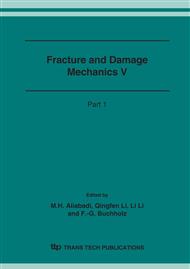p.327
p.331
p.335
p.339
p.343
p.347
p.351
p.355
p.359
Novel Structural Damage Indices: Vibration Transmissibility and its Curvatures
Abstract:
A new definition of vibration transmissibility, “the ratio of FRFs (Frequency Response Functions)”, is proposed to provide novel structural damage indices, i.e., vibration transmissibility and its real and complex curvatures. Using the FRF and its real and complex curvatures as references, the fundamental studies on performance of damage indices to reflect structural low-level damages are conducted using vibration-based nondestructive evaluation of a frame structure. The experimental results demonstrate that the sensitivity of the damage indices increases in the order of vibration transmissibility or FRF, and its real and complex curvatures. While the vibration transmissibility and its real and complex curvatures possess higher damage sensitivity than the FRF counterparts. The proposed novel damage indices are promising to develop viable and advanced structural nondestructive evaluation techniques.
Info:
Periodical:
Pages:
343-346
Citation:
Online since:
November 2006
Authors:
Price:
Сopyright:
© 2006 Trans Tech Publications Ltd. All Rights Reserved
Share:
Citation:


